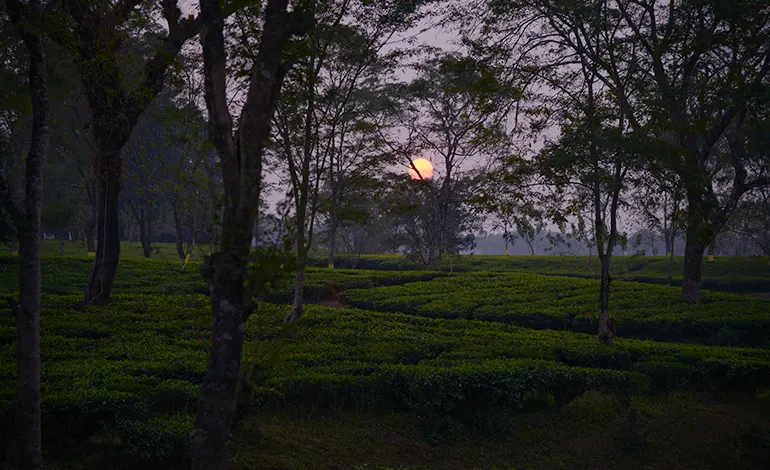
National Parks & Monuments Close To Baradighi, Dooars
Where are you? Of the many wonders of fusions of nature's virgin innites and man's enveloping creations,I am proudly one of them. I reside 45 kilometres away from the enchantingly small railway station at New Jalpaiguri, the garden mingles into the surrounding landscape in the rich green of the unending tea gardens that border National Highway - 31. Nestled in the many riverbanks of the region, I boast a sprawling 507 hectares of tea plantations.
GORUMARA NATIONAL PARK
The Gorumara National Park has fifty recorded species of mammals, 194 species of bird, 22 species of reptiles, 7 species of turtles, 27 species of fish, and other macro and micro fauna. The Park is rich in large herbivores including Indian rhinoceros, gaur, Asian elephant, sloth bear, chiral, and sambhar deer. Tigers are occasionally spotted here. It also has numerous small carnivores including various civets, mongoose and small cats.
Birds at the Gorumara National Park include submontane forest birds like the scarletminivet, sunbird, Asian paradise flycatchers, spangled drongo, and Indian hornbill.The Park is also home to a large number of snakes, venomous and non-venomous, including the Indian python, one of the largest snakes in the world, and the king cobra — the world’s largest venomous snake.
CHAPRAMARI WILDLIFE SANCTUARY
The Chapramari Wildlife Sanctuary has a total coverage of 960 hectares of forest. A large variety of flora and fauna are found here. Chapramari is known for its elephant population. Gaurs are not uncommon in the region. Rhinoceros, deer, boars, and leopards are also found here. However, Royal Bengal Tigers are not found here. The place is popular with bird watchers, with parakeets, kingfishers, and green pigeons found in abundance.
JALDAPARA NATIONAL PARK
Established in 1941, the Jaldapara National Park is situated at the foothills of the Eastern Himalayas in Alipurduar District of North Bengal and on the banks of the Torsa River. The nearby Chilapata Forest is an elephant corridor between Jaldapara and Buxa Tiger Reserve. The forest is mainly savannah covered with tall elephant grasses. The main attraction of the Park is the Indian one-horned rhinoceros. The Park holds the largest rhino population in India after Kaziranga National Park in Assam. Other animals in the Park include Indian leopard, Indian elephants, sambhar deer, barking deer, spotted deer, hog deer, wild boars, and gaur.
Jaldapara is a paradise for bird watchers. It is one of the very few places in India where the Bengal florican is sighted. The other birds to be found here are the crested eagle, Pallas’s fish eagle, shikra, Finn’s weaver, Jungle fowl, peafowl (peacock),panridge, lesser-pied hornbill. Pythons, monitor lizards, kralts, cobras, geckos, and about eight species of fresh water turtles can also be seen in abundance here.
BUXA RESERVE AND FORT
The fort is located at an altitude of 867 meters(2.844 feet) in the Buxa Tiger Reserve, Alipurduar district.It is located 30 kilometers from Alipurduar, the nearest town. The Bhutan King used the fort to protect the portion of famous SilkRoute connecting Tibet with India, via Bhutan.
The Buxa Reserve ranges in altitude from 200 feet in the Gangetic Plains to 5,740 feet bordering the Himalayas in the north. At least 284 bird species inhabit the reserve. Mammals include Asian elephant, gaur, Sambar deer, clouded leopard, Indian leopard, and Bengal tiger. There are a number of trekking routes through the jungle. There is a 4 km further trek to Rovers’ Point or Romney Dara (the land of beautiful birds at 4,500 feet.
MURTI RIVER
The Murti River originates high in the mountains of the Neora Valley National Park. Starting its journey from near the Bengal – Sikkim – Bhutan border, the river runs downs the hills to enter into the Dooars region. For much of its route, the Chapramari Wildlife Sanctuary falls to the eastern side of the river and the western side sees some of the best and most picturesque tea gardens of Dooars. After crossing Dhupjora, the Murti River flows through both the Chapramari Wildlife Sanctuary and the Gorumara National Park. The riverside is one of the most picturesque and serene sights in the Dooars Valley. The river is fed by monsoons, and during the dry months, it can be easily crossed by foot.Many of the watchtowers of Gorumara and Chapramari forests are built on the banks of the MurtiRiver.
